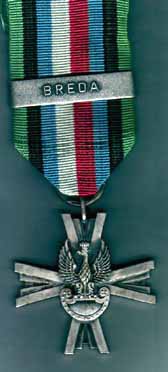WW II Polish Forces in Exile Awards: Order of Virtuti Militari; Cross of Valour; Monte Cassino Cross
A Polish Division (2nd DSP), fought in France in 1940 but was forced into Switzerland, where the soldiers remained interned until the end of the War. Other Polish units were also formed in France in 1940 including the Podhale Brigade which participated in the battle for Narvik. After France fell, many evacuated Poles ended up in Scotland and Great Britain. Among them were those that would form the Polish 1st Independent Parachute Brigade (Arnhem, operation Market Garden) and the 1st Polish Armoured Division which fought at Caen and at the Falaise Gap. Also among them were those that served in the R.A.F. Polish Squadrons.
A majority of the Polish Army Officers captured by Russian forces in 1939 (an estimated 14,000 but likely many more) were massacred by the NKVD (later becoming the KGB) at Katyn and other places. Many enlisted men were executed as well. The Poles that were permitted to live were sent into forced labour or camps in such places as Siberia. These Poles were permitted to leave the Soviet Union to join Western Forces after Germany invaded Russia in June 1941. This group of Poles made their way through Iran., Iraq and Syria to join British Forces in Palestine. This Force went on to fight in Italy and became the Polish 2nd Corps under General Anders, which fought under British command as part of the 8th Army. For a true story about a Pole who escaped the USSR to join the Exile Forces, check out Without Vodka by Aleksander Topolski http://www.withoutvodka.com/index.htm
Because these forces served under British command, they were awarded some British medals. Click here for details.
The awards of the 2nd Republic (1918-1939) were continued and a few more awards were added. Some, like the Virtuti Militari and the Cross of Valour were re-established. Other awards such as the Active Service Medals (Army, Navy, Airforce and Merchant Marine) and the Monte Cassino Cross were created to commemorate service during the 2nd World War.
1. Order of the White Eagle
2. Order of Virtuti Militari
I class
3. Order of Virtuti Militari
II class
4. Order of Virtuti Militari
III class
5. Order of Virtuti Militari
IV class
6. Order of Virtuti Militari
V class
7. Order of Polonia Restituta
I class
8. Order of Polonia Restituta
II class
9. Order of Polonia Restituta
III class
10. Order of Polonia Restituta IV class
11. Order of Polonia Restituta V class
12. Cross of Valour
13. Gold Cross of Merit with Swords
14. Gold Cross of Merit
15. Silver Cross of Merit with Swords
16. Silver Cross of Merit
17. Bronze Cross of Merit with Swords
18. Bronze Cross of Merit
19. Monte Cassino Cross (Commemorative)
20
A. Army Service Medal
B. Navy Service Medal
C. Air Force Service Medal
D. Merchant Marine Service
Medal
RIBBONS
WW II Polish Forces in Exile Awards: Order of Virtuti
Militari; Cross of Valour; Monte Cassino Cross

Army Active Service WW II Exile (London version).

Cross for Polish Forces in the West- bar for BREDA. Bars were
issued for various battles, including MONTE CASSINO.
Active Naval Service WW II Exile.
Home Army (Armia Krajowa) Cross. This commemorative Cross was
instituted in 1966 by the Polish Government in Exile. This example
was made in Poland. Other examples were made in England. The
English version has a Moire ribbon of higher quality.
 |
 |
|
|
|
Later, a Polish Jerusalem Cross was awarded as a commemorative decoration by the Exile government. It has a large Polish Eagle in a shield on the obverse and is on a different ribbon (white with a wide red stripe on each side).
Pilot (left) and Observer Wings. Marked J. R. GAUNT AND SON LONDON
on reverse.